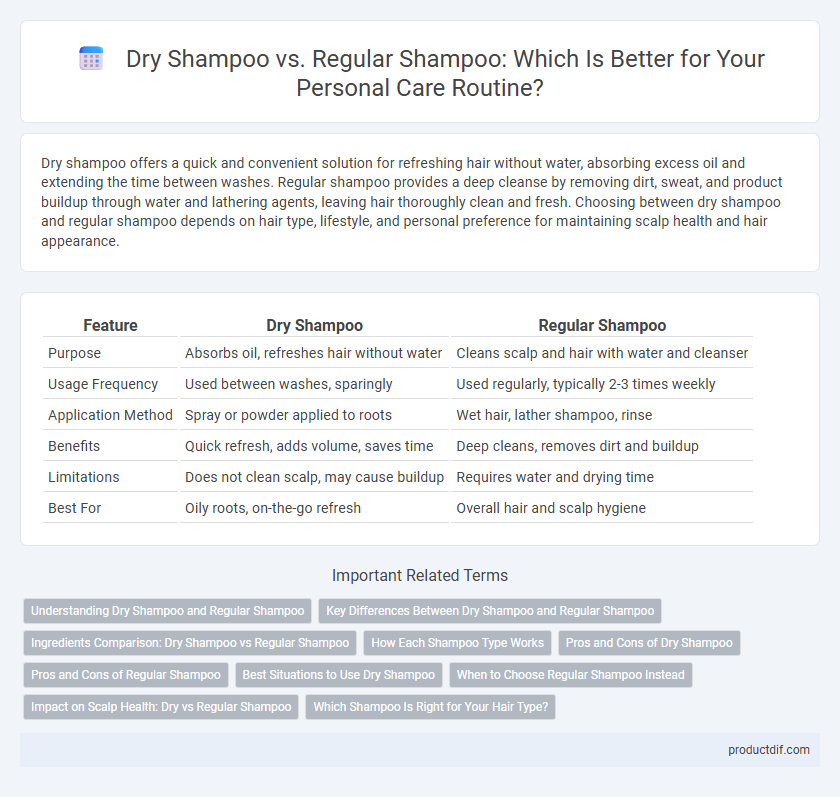Dry shampoo offers a quick and convenient solution for refreshing hair without water, absorbing excess oil and extending the time between washes. Regular shampoo provides a deep cleanse by removing dirt, sweat, and product buildup through water and lathering agents, leaving hair thoroughly clean and fresh. Choosing between dry shampoo and regular shampoo depends on hair type, lifestyle, and personal preference for maintaining scalp health and hair appearance.
Table of Comparison
| Feature | Dry Shampoo | Regular Shampoo |
|---|---|---|
| Purpose | Absorbs oil, refreshes hair without water | Cleans scalp and hair with water and cleanser |
| Usage Frequency | Used between washes, sparingly | Used regularly, typically 2-3 times weekly |
| Application Method | Spray or powder applied to roots | Wet hair, lather shampoo, rinse |
| Benefits | Quick refresh, adds volume, saves time | Deep cleans, removes dirt and buildup |
| Limitations | Does not clean scalp, may cause buildup | Requires water and drying time |
| Best For | Oily roots, on-the-go refresh | Overall hair and scalp hygiene |
Understanding Dry Shampoo and Regular Shampoo
Dry shampoo uses absorbent powders like starch or silica to remove excess oil and refresh hair without water, making it ideal for quick touch-ups or extending time between washes. Regular shampoo contains cleansing agents called surfactants that remove dirt, sweat, and oils through rinsing, providing a deep clean and scalp care. Understanding these differences helps choose the right product based on hair type, lifestyle, and scalp condition.
Key Differences Between Dry Shampoo and Regular Shampoo
Dry shampoo uses starches and alcohol-based agents to absorb excess oil and refresh hair without water, making it ideal for quick touch-ups and extending time between washes. Regular shampoo contains surfactants that cleanse the scalp and hair by removing dirt, oils, and product buildup through water-based rinsing. Unlike regular shampoo, dry shampoo does not provide deep cleaning or conditioning benefits, which are essential for maintaining scalp health and overall hair hygiene.
Ingredients Comparison: Dry Shampoo vs Regular Shampoo
Dry shampoo typically contains absorbent ingredients like starch or silica that soak up excess oil and impurities without water, while regular shampoo features surfactants such as sodium lauryl sulfate that cleanse hair through lathering and rinsing. Dry shampoos often include lightweight fragrances and minimal conditioning agents, making them convenient for refreshing hair between washes but less effective at removing dirt and buildup compared to regular shampoos. Regular shampoos combine cleansing agents with moisturizing ingredients and emulsifiers, designed to thoroughly clean the scalp and hair strands, promoting scalp health and hair strength over time.
How Each Shampoo Type Works
Dry shampoo absorbs excess oil and sweat from the scalp using starches or powders, refreshing hair without water and extending time between washes. Regular shampoo cleanses hair by creating a lather that removes dirt, oil, and product buildup through rinsing with water. Each type serves different purposes: dry shampoo offers convenience and quick freshness, while regular shampoo provides a thorough cleansing for scalp health.
Pros and Cons of Dry Shampoo
Dry shampoo offers a convenient solution for extending the time between regular washes by absorbing excess oil and adding volume, making it ideal for quick touch-ups or busy lifestyles. However, overuse can lead to product buildup, clogged pores, and scalp irritation, potentially causing dryness or dandruff. Unlike regular shampoo, which thoroughly cleanses hair and scalp with water and surfactants, dry shampoo cannot replace the deep cleaning benefits of traditional washing.
Pros and Cons of Regular Shampoo
Regular shampoo effectively removes dirt, oil, and buildup from the scalp, promoting a clean and refreshed feeling. It nourishes hair through active ingredients, improving scalp health and hair texture but may strip natural oils, leading to dryness or irritation with frequent use. Regular shampoo requires water, which can be inconvenient in situations where washing isn't feasible, unlike dry shampoo that absorbs oils without rinsing.
Best Situations to Use Dry Shampoo
Dry shampoo is ideal for refreshing hair on busy mornings, between washes, or during travel when water access is limited. It effectively absorbs excess oil and adds volume without the need for water, making it perfect for post-workout or quick styling touch-ups. Unlike regular shampoo, dry shampoo saves time and preserves hair color by reducing wash frequency.
When to Choose Regular Shampoo Instead
Regular shampoo should be chosen when the scalp or hair requires a thorough cleansing to remove dirt, excess oils, and product buildup that dry shampoo cannot fully eliminate. It is essential after activities involving heavy sweating, exposure to pollutants, or when aiming to maintain scalp health and hygiene. Using regular shampoo also helps restore moisture and prevent scalp irritation caused by prolonged use of dry shampoo.
Impact on Scalp Health: Dry vs Regular Shampoo
Dry shampoo absorbs excess oil and sweat, offering a quick refresh without water but may leave residue that can clog pores and irritate the scalp if overused. Regular shampoo cleanses deeply by removing dirt, oil, and buildup, promoting a healthier scalp environment and supporting natural hair growth. Balancing the use of dry shampoo with regular washing helps maintain scalp hygiene and prevents issues such as dandruff and folliculitis.
Which Shampoo Is Right for Your Hair Type?
Dry shampoo is ideal for oily or fine hair types needing quick oil absorption and volume between washes, while regular shampoo suits all hair types for thorough cleansing and scalp care. Hair texture and scalp condition dictate the best choice; curly or thick hair often benefits from regular washing to maintain moisture. Selecting the right shampoo depends on frequency of washing, lifestyle, and specific hair needs to balance cleanliness without stripping natural oils.
dry shampoo vs regular shampoo Infographic

 productdif.com
productdif.com